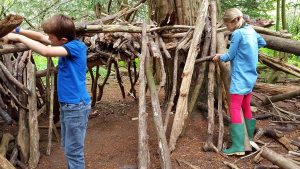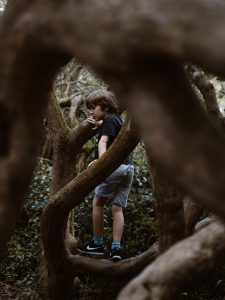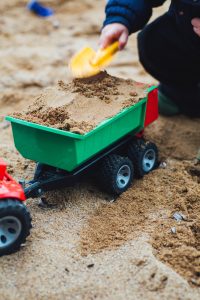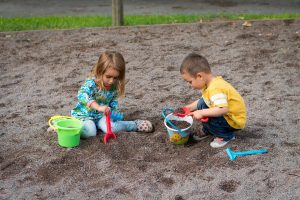Active Outdoor Play
10.1 The Benefits of Active Outdoor Play
Research shows that today’s young children spend less time outdoors engaging in active play and exploring the natural world (Clements (2004), Ginsberg (2006), Hastie and Howard (2007), The Henry J. Kaiser Family Foundation (2003), Thigpen (2007).
Researchers have identified reasons for this decline, including:
- Adult fears about crime and safety
- Increased use of television, computer games, DVDs, and smartphones and tablets with digital media
- More time spent indoors in structured activities
- Childcare arrangements with limited free time
- Loss of natural habitats
Whether children live in urban, suburban, or rural communities, the outdoor world provides new opportunities to observe, discover, and learn. In an outdoor environment, children’s cognitive capacity to appreciate beauty, express themselves creatively, and perceive sensory patterns and variety expands to all new heights (Torquati & Barber, 2005).
Pause to Reflect
Connection to the outdoors is innate. Humans require this connection for holistic health. Challenge your experiences to include a walk through the forest, your local park, or along a river or lake. Take notice of how you feel, how you breathe, and how you connect to the environment around you. What elements can you bring to the early learning outdoor spaces?
10.2 Why outside
Early childhood education research has established the importance of learning through direct experiences (Torquati, J., & Barber, J., 2011). Theorists such as Montessori and Waldorf offer direct educational practices at their centers. The philosophy of the schools of Reggio, Italy and Howard Gardner also understood and expounded upon the complementary nature of science and the aesthetic experience of young children (Edwards et al.,1998) (Gardner,1999).
Outdoor play and exploration benefit children in many ways. Researchers have identified some general positive outcomes (Moore and Marcus, 2008) (White, 2004), including:
- Increased creativity and imagination
- Development of a sense of wonder, which is an essential motivator for lifelong learning
- Increased social interactions between children
- Enhanced opportunities to make decisions, solve problems and collaborate with peers, which also promote language and communication skills
- Improved awareness, reasoning, and observation skills
- Positive effects on children’s ability to focus and pay attention
The outdoors offers rich learning opportunities for children of all ages. Whether in outdoor play spaces, backyards, parks, or on front stoops, these opportunities take shape and place through relationships and interactions between caring, supportive adults, and children. Young children take their cues from the significant adults in their lives. They are more likely to respond positively and explore the outdoor environment when adults plan for, model, and support those explorations. Because educators and families play an essential role in connecting children to nature and the outdoors, educators must consider ways to facilitate and strengthen adult engagement with outdoor play and exploration.
Indigenous Perspective
Many Indigenous nations recognize that the land provides a connection for all living beings. While it is critical for people to be outside and on the land, it is particularly important for young children, so they have an opportunity to develop relationships with their kin. Being “grounded” is not a negative concept for Indigenous people, instead, it refers to connecting with the land. Children who spend time outdoors learn how to be present in their surroundings as they interact with nature.

Pause to Reflect
Canada is blessed with a variety of seasons and temperatures. Sometimes going outside can be challenging in the humidity of summer or the cold of winter. In addition to the positive outcomes listed above, why is it good for adults to get outside? Have you been for a walk recently? Why or why not?
10.3 The Importance of Risk
Risk is an important component of outdoor, nature-based play. It would be negligent to both avoid and ignore risk as an element of the outdoor environment. As with the indoor environment, educators need to focus on the real and the significant risks present in the environment. A risk-benefit assessment should be conducted each time a program plans to engage young children in the outdoors (Motion, 2018). The benefits identified previously outline the positive impact outdoor play can have on the developing child; what risks are present?
A sense of risk needs to include:
- Speed
- Height
- Dangerous tools (hammers & saws)
- Dangerous elements (fire & water)
- Rough & tumble plan
- Sense of getting lost
Risk is often correlated to injuries that may result. Small cuts and bruises, which heal quickly, should be anticipated as a normal part of growing up. Moderate injuries are defined as those injuries which result in time off work or school and would require formal reporting to governing bodies. Serious injuries are defined as those that result in long-term effects such as traumatic brain injuries, amputation, or death (Brussoni, 2018). A visit to the hospital is not a criterion for classification as a serious injury. Often, the risk is avoided with the goal of reducing injuries.

10.4 Loose Parts
Educators can use “loose parts” to enhance outdoor play opportunities for all age groups. The term refers to “easily moved materials that children may use while playing (Dempsey and Strickland). For example, for infants and toddlers, loose parts are toys and materials that are safe, not fixed in place, and can be used in many ways. They are materials that children collect, put together, mix, separate, stack, fill and dump, and line up. Indoor toys, equipment, and materials brought outside are considered loose parts, as are natural materials such as tree cookies, stones, twigs, seedpods, leaves, water, and sand. Other ideas for loose parts include:
- Fabric
- Containers
- Polyvinyl chloride (PVC) pipes
- Sponges
- Wagons
- Small sleds
- Plastic milk crates
- Backpacks
- Wide, sanded boards that are short enough for toddlers to pick up, carry, or drag
- Encourage children to manipulate the environment and provide opportunities for creativity and problem-solving.
- Provide children with age-appropriate materials. Because these materials can be used in various ways, each age group uses them in different and appropriate ways.
- Add novelty into the outdoor play environment. This is important for cognitively higher levels of play, such as symbolic play.
- Foster a wide variety of play behaviors, such as dumping and filling; lifting, moving, and carrying; and pretend parallel, and cooperative play. (Dempsey and Strickland)

10.5 Sand Play and Water Play
Whenever possible, opportunities for exploration with sand and water are best provided outdoors. When these experiences are attempted indoors, safety issues can limit how the children use the materials. For example, a child who is trying to figure out if all the water in a tall narrow jug is going to fit in a small round bowl is probably going to end up spilling. This is valuable information that would be lost if the child were being reminded not to spill any water on the floor because their friends might slip.
Sand play and water play are often referred to as “sensory play” because they stimulate children’s senses which, in turn, develops sensory processing abilities in the brain.
Alternatives to sand and water play as sensory experiences are endless, including using food. However, there are differing opinions about using food in sensory bins in early learning settings; for example, uncooked rice or beans. Those who caution against the use of food cite choking hazards, sanitary issues, allergies, and wastefulness.

Important Things to Remember
- Researchers have identified that outdoor play and exploration can increase creativity and imagination in young children.
- Young children are more likely to respond positively and explore the outdoor environment when adults plan for, model, and support those explorations.
- What is perceived as risky to one person, may not hold the same risk for another. Children and educators need to be taught to trust their own judgement.
- Conversations with children will help them develop their own risk assessment and provide them with language to talk about their own abilities.
- The term “loose parts” refers to easily moved materials that children may use while playing.
- Loose parts provide opportunities for creativity and problem-solving as well as encourage higher levels of play, such as symbolic play.
Supplemental Readings
References
Brussoni, M. (2018, February). Outdoor play and national outdoor play position. Outdoor Play- based Learning Study Tour. Glasgow, Scotland.
Clements, R. “An Investigation of the Status of Outdoor Play.” Contemporary Issues in Early Childhood 5, No. 1 (2004): 68–80.
Dempsey, J., & Strickland, E. (1992). The “whys” have it! Why to include loose parts on the playground. In A right to play: Proceedings of the American association for the child’s right to play. Denton, Texas. 1992; SECA: Little Rock, Arkansas, 1993. In Scholastic Early Childhood Today. Retrieved from http://www.scholastic.com/teachers/ article/staff- workshopteacher-handout-quotwhysquot-have-it-why-include-loose-parts-playground
Edwards, C., Gandini, L. & Forman, G. (1998). The hundred languages of children: The Reggio Emilia approach- Advanced reflections. 2nd ed. Greenwich, CT: Ablex.
Ginsburg, K. “No Child Left Inside: Reconnecting Kids with the Outdoors.” Testimony of Kenneth Ginsburg, MD, MS Ed, FAAP, on behalf of The American Academy of Pediatrics to the Natural Resources Subcommittee on National Parks, Forests and Public Lands and Subcommittee on Fisheries, Wildlife and Oceans, May 24, 2006.
Gardner, H. 1999. Are there additional intelligences? The case for naturalist, spiritualist, and existential intelligence. In Education, information, and transformation, ed. J. Kane, 111- 31. Englewood Cliffs, NJ: Prentice Hall.
Hastie, Kyla; Shani Howard. “A Prescription for Healthy Kids: Nature & Play.” AthensParent.com (March/April 2007).
The Henry J. Kaiser Family Foundation. “New Study Finds Children Age Zero to Six Spend as Much Time With TV, Computers and Video Games as Playing Outside.” Washington, DC: Kaiser Family Foundation. Oct. 28, 2003.
Louv, Richard. Excerpt from Last Child in the Woods: Introduction. Chapel Hill, NC: Algonquin, 2008
Moore, Robin C; Clare Cooper Marcus. “Healthy Planet, Healthy Children: Designing Nature into the Daily Spaces of Children.” In Biophilic Design: The Theory, Science, and Practice of Bringing Buildings to Life. Hoboken, NJ: Wiley (2008): 153–203.
Thigpen, Betsy. “Outdoor Play: Combating Sedentary Lifestyles.” Zero to Three 28, No. 1 (2007): 19–23.
Torquati, Julia; Mary M. Gabriel, Julie Jones-Branch, Jennifer Leeper Miller. “Environmental Education: A Natural Way to Nurture Children’s Development and Learning.” Spotlight on Young Children and Nature. Washington, DC: National Association for the Education of Young Children (2011): 8–14.
White, Randy. “Young Children’s Relationship with Nature: Its Importance to Children’s Development & the Earth’s Future.” White Hutchinson Leisure & Learning Group, 2004.

